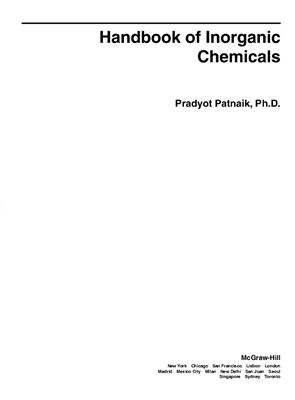McGraw-Hill, 2003. - 1086 p.
This handbook is an encyclopedic treatment of chemical elements and their most important compounds intended for professionals and students in many areas of chemistry throughout the manufacturing, academic, and consulting communities. Chemicals are presented in alphabetical order in a descriptive format highlighting pertinent information on physical, chemical, and thermodynamic properties of chemicals, methods of preparation, industrial applications, chemical analyses, and toxic and hazardous properties. Synonyms, CAS Registry Numbers, brief history of discovery and natural occurrence are provided for many entries. The objective is to provide readers a single source for instant information about important aspects each substance. In this sense it should serve as a combination handbook and encyclopedia.
Readers may note three unique features in this text. First, there is a substantial discussion of chemical reactions of all elements and many of their compounds, a practice abandoned nowadays by most mode reference and handbooks. Second, analytical methods are presented for identification and measurement of practically all entries. In many instances, the method is based on my own research and experience. Third, a preparation method is given for all entries. For most compounds, more than one preparative method is presented, covering both laboratory and commercial production. Also, a brief history of the discovery and early production of selected elements is presented to serve as background against which
This handbook is an encyclopedic treatment of chemical elements and their most important compounds intended for professionals and students in many areas of chemistry throughout the manufacturing, academic, and consulting communities. Chemicals are presented in alphabetical order in a descriptive format highlighting pertinent information on physical, chemical, and thermodynamic properties of chemicals, methods of preparation, industrial applications, chemical analyses, and toxic and hazardous properties. Synonyms, CAS Registry Numbers, brief history of discovery and natural occurrence are provided for many entries. The objective is to provide readers a single source for instant information about important aspects each substance. In this sense it should serve as a combination handbook and encyclopedia.
Readers may note three unique features in this text. First, there is a substantial discussion of chemical reactions of all elements and many of their compounds, a practice abandoned nowadays by most mode reference and handbooks. Second, analytical methods are presented for identification and measurement of practically all entries. In many instances, the method is based on my own research and experience. Third, a preparation method is given for all entries. For most compounds, more than one preparative method is presented, covering both laboratory and commercial production. Also, a brief history of the discovery and early production of selected elements is presented to serve as background against which

